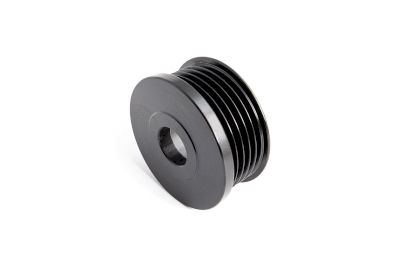What Is a V-Belt Pulley?

A V-belt pulley is a disk-shaped component used to transmit power using a V-belt.
The V-belt pulley is a belt with a V-shaped cross section and is used in combination with the V-belt pulley, which has a V-shaped groove and a larger contact area than the flat belt and pulley, resulting in higher transmission efficiency.
V-belt pulleys are used in many rotating machines, and V-belt pulleys are one of the most frequently used pulleys in Japan.
Uses of V-Belt Pulleys
V-belt pulleys are used in a wide variety of equipment, from home appliances to industrial equipment. The following are examples of V-belt pulley applications:
- Belt conveyors and compressors
- Automobiles and bicycles
- Industrial pumps
- Portable generators
Due to the strong engagement between the belt and pulley, V-belt pulleys are used in machines that rotate at high speeds. On the other hand, V-belt pulleys are not suitable for use when the distance to the power transmission object is short.
When the distance is short, flat belts tend to be used, which are subject to less wear.
Principle of V-Belt Pulley
The V-belt has a V-shaped cross section, and the V-belt pulley has V-shaped grooves dug into it; the V-belt fits into the grooves of the V-belt pulley and rotates the pulley by friction.
The key points of power transmission are belt tension and belt surface roughness.
1. Belt Tension
The stronger the belt tension, the stronger the engagement with the pulley, which creates higher transmission efficiency. However, too much tension may cause the belt to break, so proper adjustment is necessary.
The strength of the belt tension can be quantitatively controlled by using a belt tension gauge.
2. Surface Roughness
V-Belt pulleys have a wide range of contact surfaces with the belt, so the roughness of each contact surface is an important factor in determining transmission efficiency. The rougher the surface creates a higher frictional force and the higher the transmission efficiency.
On the other hand, it also has the disadvantage of increasing wear and shortening the life of the machine. After prolonged use, the grooves on the V-belt pulley gradually become worn and the surface becomes smooth. In this condition, the belt and pulley tend to slip and transmission efficiency is reduced, so replacement is necessary.
Other Information on V-Belt Pulleys
1. Centering of V-Belt Pulley
If the V-belt pulley is used with the motor side misaligned with the machine side, the V-belt pulley and pulley will wear faster, and an unexpected load will be applied to the equipment. This condition is expressed as “off-centering.”
To prevent the above, centering of V-belt pulleys is a very important operation. Centering using water thread is a widely used method. Yarn is applied to the upper and lower surfaces of the pulley on the motor side and the machine side, and the lifting of the yarn is compared.
With the yarn pressed against one side, the other side is floated, and the timing when the yarn leaves the pulley surface is checked. This method allows visual confirmation of the parallelism and misalignment of the surfaces, and is repeated several times while making fine adjustments.
In recent years, laser centering devices have become widely available because they are easy to use and highly accurate.
2. Wear of V-Belt Pulley
V-belts and V-belt pulleys gradually wear over time. Since V-belts wear out faster, V-belts need to be replaced more frequently. However, V-belt pulleys also wear gradually and need to be replaced as they age.
The wear rate of a V-belt pulley can be measured with a measuring instrument called a groove gauge; the groove gauge is pressed against the groove of the V-belt pulley and the gap between the groove and the groove gauge is measured with a gap gauge. The groove gauge must be used according to the standard of the V-belt pulley, such as the ISO standard, or wedge belt.
Different groove gauges should be used depending on the diameter of the V-belt pulley. It is necessary to confirm the standard and size of the V-belt pulley to be measured in advance.
As for the wear limit, in most cases, the manufacturer’s allowable value is 0.8 mm gap. However, since it varies depending on the model, the allowable value of the V-belt pulley used should be checked before measurement.